
Home > Manufacturing-Operation Management > World Class Manufacturing > Manufacturing Strategy
Manufacturing Strategy can be considered as a pattern of choices made in order to achieve the full competitive capability of a business unit. These strategies are either explicit drawn up or implicitly realised as manifested in a stream of real time decisions made at different points of time. The author attempts to explain the important characteristics of a manufacturing strategy from a conceptual angle and then outlines the pattern of strategic decisions that emerge from the kind of structures and infrastructures that exist in Indian Organizations.
The term “Strategy’, has its origin in a military context to mean “Generalship or maneuver-ability in a war”. The term signifies, in a business, an integrated pattern of decisions made and subsequent actions taken to reach specified goals. It is expressed in terms of both the intent (i.e. goals or objectives) and means i.e. actions to be undertaken (Greenwood & Thomas, 1981). It is thus a plan, a position, a ploy, or a mental image (Mintzberg & Quinn. 1991). It governs important decisions having long term organisation makes between its internal resources and skill and the opportunities and risks created by its external environment”. (Hofer & Schendel. 1978). It is also recognised as the mean of developing competitive advantage with a particular business unit related to a specific product/market segment (Porter, 1985). It is the means by which some of the chosen values adding activities are carried out in such a way as to provide distinctive benefits to a customer. Though marketing is a function interfacing with customers, distinctive advantages could not be delivered by the manufacturing function. It is now recognized that a business unit should be concerned about strategic perspective of the manufacturing function. And thus, a manufacturing strategy could be considered as a pattern of choice made in order to realize competitive capability of a business unit. Till now, manufacturing function, spanning from receipt of raw materials through delivery of finishing goods go customers, has not been given due recognition in strategic management literature.
Theoretically, a strategy could exist at any level of dis-aggregation of an organisation system. However, three levels-corporate, business and functional – are often discussed and made use of in a practical situation Corporate strategy is concerned with what types of business the company, as a whole, should be in and how changes to be made in those types. These issues constitute corporate planning. Financial return, growth and fulfillment of other powerful stakeholders interests are the objectives which are pursued in deciding such issues. Business strategy is concerned with how to compete in a specific product-market situation. Such a strategy is also known as a competitive strategy. Porter (1980) argues that a business unit or firm, through competitive strategy, seeks to define and establish an approach to competing in the concerned industry. Such a competitive strategy could be effective if it offers a sustainable competitive advantage over existing and potential competitors (Porter, 1985). There are broadly three generic competitive strategies – low cost leadership, product differentiation and segmentation or focused approach with potentially of providing such competitive advantages.
Lower cost is the ability of a firm to design, produce and market a comparable product more efficiently than the competitors. Korean steel and semiconductor producers, for example have penetrated against foreign competitors using this strategy. Differentiation is the ability to provide unique and superior value to the buyer in terms of product quality, special features or after-sales service. German machine differentiation strategies involve high product performance, reliability and responsive services. Focused approach is visible in many industries. In automobiles, leading American and Japanese companies have wide product lines, while BMW and Daimler Benz (Germany) emphasize high performance cars and Hyundac and Daewoo (Korea) focus on compacts and sub compacts.
With the boundaries of the business and the desired competitive advantages identified, each functional area (typically, marketing and sales, manufacturing and R & D) develop strategies that support that business focus.

Each of the functional strategies will have interactive relationships with business strategy and among one another. Relationships are proactively decided. Among all the other functions, manufacturing is the most misunderstood function from a strategic point of view.
Increasing level of competitions and rapid evolution of production technology have, of late, drawn attention of policy makers to look at the manufacturing function from a strategic perspective. Skinner (1969) pointed out that a lack of awareness among top executives that a production system inevitably involves trade off and compromises and so must be designed to perform a limited task well, with that defined by the corporate strategy. Skinner (1985) subsequently clarified that (1) there are many ways to compete besides producing at low cost. (2) a factory can not perform well on every yardstick and (3) simplicity and repetition breed competition. He further mentioned that the traditional model seems to be that corporate strategy is often set with little reference to the existing manufacturing structure. While the overall strategy is carefully translated into product strategy and marketing mix, the manufacturing function is simply expected to cope with the outcome.

Western countries have now realised the strategic role of manufacturing function. For example, Abernathy (1978) says, “the primary sources of this advantage are found, instead, in the Japanese execution of a well designed strategy based on the shrewd use of manufacturing excellence. The Japanese cost and quality advantages originate in painstaking strategic management of people, materials, and equipment that is, in superior manufacturing performance”. The concept of manufacturing strategy has now been formalised as the means by which the capabilities of the manufacturing function are developed to support the desired competitive advantage of the business units, and to complement the efforts of the other functions. Operationally, such capability and support are determined by the pattern of decisions that are made in manufacturing
An appropriately built up manufacturing function only could make a business unit realise a competitive performance by producing error free products, getting goods to the customer quickly invariably keeping delivery promises, being able to introduce innovative new products on a timely basis, providing a range of products wide enough to satisfy the customer requirements, being able to change valumes or delivery dates to customer demands and always important, it determines the company’s ability to offer products at a price which either undercuts the competitors or gives a high margins or both (Slack 1991). Thus the manufacturing function is going to be the key focus formulation and execution of a competitive strategy. A proactive manufacturing strategy will provide the needed strength and linkages as shown below:

Although there is no generally accepted definition of a manufacturing strategy, several explanations have appeared which specify what it does or what it addresses. There seems to be an agreement that manufacturing strategy should act to support corporate objectives (Skinner, 1978; Wheelwright, 1984), provide manufacturing objectives which offer the firm a competitive advantage (Hayes & Wheelwright, 1979) and focus on a consistent pattern of decision making within key manufacturing resource categories (Hayes & Wheelwright, 1984; Edmondson and Wheelwright, 1989; Hill, 1989).
A manufacturing strategy could be defined as “a collective pattern of coordinated decisions that act upon the formulation, reformulation and deployment of manufacturing resources and provide a competitive advantage in support of the overall strategic initiative of the firm or the SBU” (Marucheck, Pannesi & Anderson, 1990). Slack (1991) defines manufacturing strategy as “the set of coordinated tasks and decisions which need to be taken in order to achieve the company’s required competitive performance objectives”. Slack’s definition relates manufacturing strategy with manufacturing objectives whereas the former definition links it with the business objectives. Another school of thought relates it to world class manufacturing . Rickard Schonberger (1986) who led this school, defines world class manufacturing as "Today there is wide agreement that continual improvement in quality, cost, lead time, and customer service is possible, realistic, and necessary’. and that one more primary goal, improved flexibility, is also part of the package”. According to Schonberger “with agreement on the goals, the management challenge is reduced to speeding up the pace of improvement.” A manufacturing strategy could thus be thought as “a blueprint for action towards world class manufacturing: a pattern of decision to be executed in line with overall business goals or objectives mostly through a gradual process” (Roth, Giffi & Seal, 1992). This definition stresses that a manufacturing strategy ensures a business to move towards a direction with a view to attain the manufacturing excellence. Manufacturing excellence is broadly defined as a dynamic process that provides unique value, competitive advantage and delight to customers and suppliers through the development of internal operations capabilities that foster continuous improvements in human assets, technology materials and information flows, that are synergistic with the total business, and that provide a sustainable competitive position in the firm’s target markets” (Roth et. Al 1992). Since there many constraints towards achieving the above mentioned goals a manufacturing strategy could also be probed into from a perspective of constraints. The essence of strategic planning in manufacturing should therefore be a dynamic process of identification and removal of internal and external constraints towards achieving higher level of performance in terms of short term and long term corporate profitability (Weston, 1992). All these definitions point out that there is a set of performance objective based on which future competition battle will be fought. Manufacturing process has to equip itself with the right capability so that the concerned business could keep on winning the battle at an point of time. These performance objectives have been termed differently by various authors. Manufacturing mission, competitive priority, manufacturing advantages, manufacturing objectives, etc. are some of the examples.

There has been surprising amount of unanimity in defining manufacturing objectives or criteria. These criteria are:
It may be mentioned here that the term ‘Today Quality’ as used sometimes in ‘Total Quality Management’ embraces all the above mentioned criteria other than the ‘cost/price’.

Any of the manufacturing systems is a collection of different working elements, each one of them could be though of mini-manufacturing systems. Any one of them acts both as a supplier to the next element and as a customer to the previous one. It is, therefore, argued that the above mentioned criteria are to be persuade not only with respect to external customers which is definitely vital but also with internal customers (Slack, 1991). Further, externally important criteria are comparatively easier to discern but internal ones are very difficult. Internally, individual performance objectives influence and are influenced by each other. Any major improvement in manufacturing performance requires one to gain insights into both internal and improvement in manufacturing performance requires one to gain insights into both internal and external performance criteria Manufacturing strategy should therefore look at both internal external capabilities. According to Porter (1985) ‘how to compete’ is a deliberate choice of the management to decide which one to emphasize. But there are experts who argue that criteria have a time phase for development. A manufacturing firm could not compete effectively for a long time on ‘speed’ unless the concerned firm and its manufacturing process are working with high-degree of efficiency (resource productivity), dependability and quality. Growth of the performance criteria over time as visualised by Bolwijn et al (1990) is shown in Fig.1. But the criterion based on which a firm is competing must be significantly distinguishable before the customers. Such appreciable differences on some criteria are only recognised as ‘Strategic breakpoints’ (Haas, 1987).
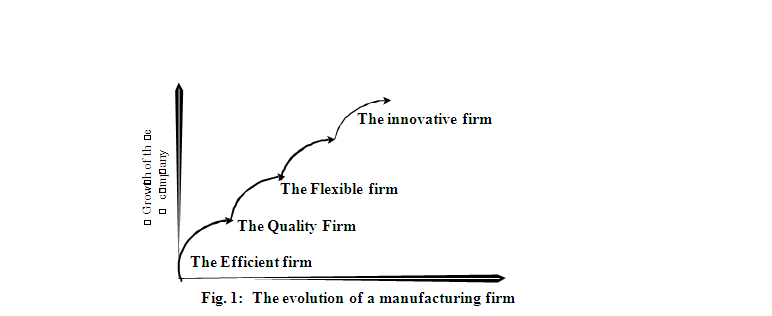
Finally it is to be mentioned that all the criteria other than those differentiating a firm from others are also important as performance of the firm on each of those criteria has to be at least comparable with others,. Thus, there are both ‘Winning Criteria’ and ‘Qualifying Criteria’ as Hill (1989) postulated. All the firms in an industry are to be equally good in all the qualifying criteria, through a specific firm may perform much better in one or two chosen winning criteria. Over time, therefore, all the firms will show progression in performance in respect of each of the manufacturing objectives or criteria as discussed above. And that’s why Scchonberger emphasizes’ ‘speeding up the pace of improvement ‘… as the only fundamental task of the management.
The first category includes decisions related to facilities, technology, capacity, locations and vertical integration. Some further details are given in table-1
Table 1 : Physical Structural Configurations
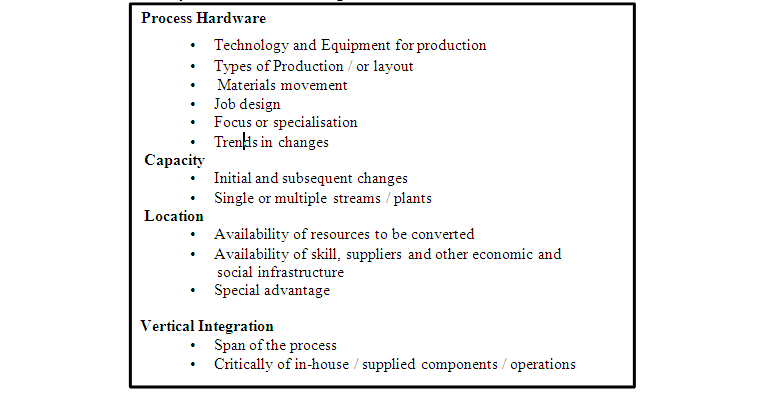
Incase manufacturing strategy is not explicitly formulated, analysis of the existing structure and the ways they are undergoing changes could throw considerable light on the manufacturing strategy being implicitly following by the concerned business unit.
There are several kinds of enabling services required for smooth manufacturing to happen. Each of these services is normally provided through well laid down systems and procedures. How effectively each of them contributes to required competitive performance is a matter of primary concern.
A manufacturing strategy is one of the functional strategies laid down to achieve competitiveness at a business unit level. A functional strategy indicates how the function will support the desired competitive advantage (the business strategy) and how it will complement and interact with the other functional strategies. A business unit, for its success, requires effective and coherent working of all the important functions – Marketing, Personnel, Finance and research & Development besides manufacturing. This interpretation of the role of manufacturing strategy in a context of functional network is very important in many countries where existing organisations are highly function-wise differentiated.
A consistent pattern of decisions in manufacturing could therefore be ensured if interfaces of manufacturing functions with key functions like marketing, personnel, finance and research & development are effectively managed. It is, therefore, visualized that such interface management should be strategically viewed to evolve a proper manufacturing strategy.
Following interfaces are important:
In the last category, decision elements relate to the relationship with an external agency. A manufacturing strategy is, after all one of the means to ensure a fit with the external environment. There are several stakeholders like investors, end users, distributors, suppliers, Government owned regulatory bodies, etc. A manufacturing strategy could only be acted upon when interests of these stakeholders are also considered. It is, therefore, emphasized that manufacturing strategy should also be concerned with the relationship build up with these stakeholders. Following relationships are important from strategic point of view.
Management scientists of post 80’s specially those working in areas of TQM and world class manufacturing are convinced that a manufacturing process should have to be improved on a continuous basis in order to ensure that the process remains competitive. Such improvements could be incremental or substantial at times. Culture, creativity and technology are some of the enablers for such improvements. Innovative designs for global markets, global sourcing, etc. are also visualized as sources for competitive advantage to be achieved through manufacturing in coming years. Manufacturing strategy should therefore be concerned about the directions of such improvements. Approach to and kinds of improvement determine future competitive capabilities of the manufacturing function. The relevant elements under this category are:
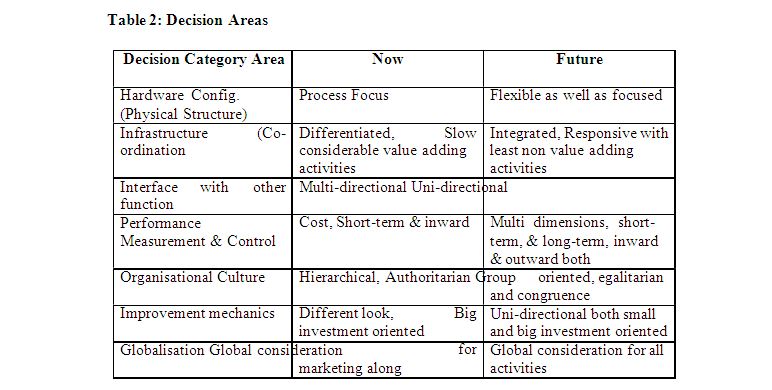
As mentioned earlier, the manufacturing function is to be fully taken into consideration in future in order to achieve competitive performance goals. Improvement directions, as argued earlier, are more or less universal. Therefore decisions in these areas are to be moving the same direction as postulated in table-2. Such directional forecasts are in conformity with various stage theories (Doll & Vonderembse, 1992).
India has a fairly large base of manufacturing industries. Though Indian industries are familiar with the techniques of corporate planning and strategic planning concepts of competitive strategy and competitive advantages at a specific product market level have not been much popular mostly on account of lack of competition in most of the manufacturing industries. Consumer goods industry, mostly dominated by private sector units along with some multi-national firms, of course, has been following some of the related principles. Marketing of brands, evolving new brands, market segmentation etc. are some of the market related strategic approaches followed by Indian Organizations. Manufacturing which is normally visualized as a supporting function to these marketing oriented strategies never have received explicit recognition of its contributions to the development of competitive advantage. Manufacturing function in most of the industries including consumer goods has been found always in a state of fire fighting towards fulfilling targets of time, cot and quality. As a result, labour productivity growth rate in Indian manufacturing sector as a whole has been low compared to those in many other Asian Countries as seen in Figs.2A and 2B. Many of the firm may loose even in the domestic market unless manufacturing function as “equivalent to doing” is considered white planning for product market strategy. After all, it is the execution i.e. production and delivery which ultimately provides satisfaction to customers and thereby the competitive advantages of the firm get manifested in terms of higher sales and lower costs.

Export markets especially, in developed countries could offer a competitive advantage if manufacturing function is strategically recognised. There is a segment in developed countries
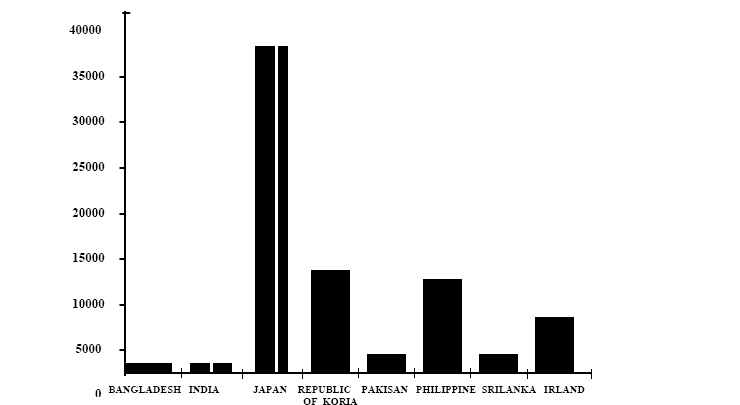
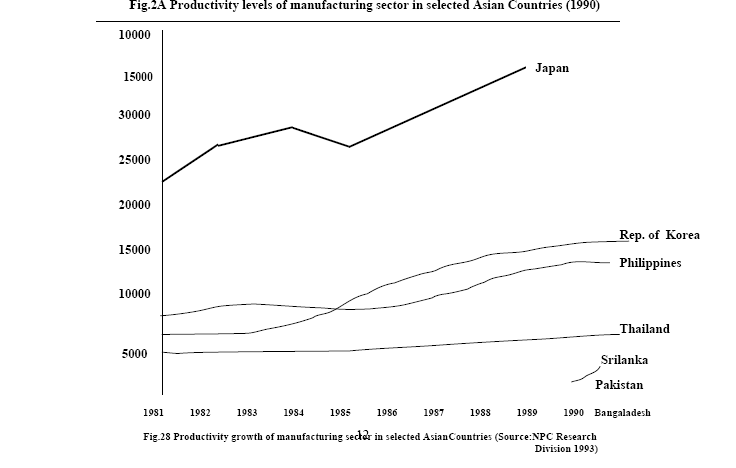

where a customer decides to buy based on customer service, tail-end customisation and flexibility besides a reasonable level of cost and quality. Flexibility in such kinds of cases could be provided through higher skilled technical labour / knowledge workers. Indian manufacturing units with proper organizational set up and infrastructure could undertake such jobs at competitive advantages in export markets too. At present almost all industrial units in India make strategic manufacturing decisions in isolation at different points of time. Benefits could be realisable if related issues are decided upon in a more focussed, comprehensive and proactive manner. This calls for an explicit formulation and implementation of a manufacturing strategy.

Since no explicity expressed manufacturing strategy exist today, the author has attempted to profile a pattern based on observations on present state of affairs in respect of each of the strategic elements of manufacturing enumerated earlier. As information has been collected mainly from secondary sources like annual reports, business magazines and limited on-the-spot observations made incidentally to the author’s consultancy work, observations herein have been made in broad terms. Further, observations are comparatively biased towards Heavy Engineering Machine tools manufacturing units and 2-wheeler personal transportation vehicle industries.
In all industries, minimisation of cost through higher resource efficiency has been the dominating performance criterion or manufacturing objective. It is only in recent years that some attention has been given to ‘conformance quality’. Many of the heavy engineering manufacturing plants are process focussed without having any specialization in terms of product lines. Most of the products are made based on one-off or a small batch quantity. There has been very limited use of group technology. Most of the machineries are general purpose. It is only recently that a few of the firms are replacing some of their conventional production equipments by Machining centres or CNC machines. Production methodology is hardly decided based on positions of individual products in their respective product life cycles. Very few plants are focussed. However, in the case of personal transportation industry, productions proceed through a limited number of specialized product lines mostly comprised general-purpose machinery dedicated to specific lines. However, only one or two recent plants in a transport vehicles industry, set up under Japanese collaborations, are equipped with specialised NC or CNC machineries.
Indian manufacturers, more or less, have much higher diversity in products being produced from the same production plant. This shows impreciseness in identification of market requirements which, in turn, poses problem in coordination. One of the successful strategies followed by a Japanese collaborating firm has been its effective product design for a specific Indian market segment. An innovative product design in conformity with the emerging requirements of customers can have significant impacts in the Indian market as in western markets.
Availability of raw materials, and skilled engineering personnel along with government incentives have been the basis for location of manufacturing plants. The total investment on the plant rises on account of having provided many social infrastructural facilities to the employed personnel. Most of the Indian manufacturers have much longer span of process than their counterparts in western countries. Lack of outside facilities or lack of confidence with outside suppliers is responsible for getting most of the important components and sub-assemblies made in-house in addition to assembly.
Indian manufacturing system is characterised by a high degree of functional specialisation with a large percentage of white colour jobs compared to shopfloor jobs. Each of the manufacturing service departments like production planning, progress, inspections, design, methods engineering, exists, most often, to exercise control rather than providing support to shop floor manufactruing personnel. 7 to 8 hierarchical levels exist in the different groups related to manufacturing function – the commitment on the part of the direct manufacturing employee is much less in the different groups related to manufacturing function - the commitment on the part of the direct manufacturing employee is much less in such a hierarchical manufacturing set up.

Quality Control is usually inspection oriented production linked incentive schemes only act as an effective motivator for the direct manufacturing personnel to comply with a given production plan. Production planning is done at a centralised level by production planning and control system is yet to start in a big way. Raw material and in-progress inventory is comparatively higher. For example, even in the personal transportation industry, the average inventory of raw materials and in-progress materials is about twice that maintained by a firm having Japanese collaboration in the same industry.
Manufacturing units in Indian still follow an adversenal relationships with suppliers, through an air of change is blowing in this direction a few firms have bilt up a very good relationships with suppliers dealers and distributors. In most of the manufacturing units, financial and personnel policies have often been offering conflicting demands on the manufacturing function. Though marketing function is gradually gaining recognition, better management of interfaces between the marketing and design departments has not got under way. Research and development departments in many of the Indian organisations are yet to provide valuable contribution in new product development.
Though quality and timeliness are measured at the operational level, cost is the only important performance parameter which draws the attention of higher management. Control has been the dominating management style in all the functional segments of an organisation. Control has been the dominating management style in all the functional segments of an organisation. Improvement is made at the tactical level mostly on the initiative of the functional specialists. Industrial engineering department, if existing, is busy in operationalisation of incentive schemes. Quality improvement efforts are limited to process certification. Globalization is thought in terms of import of technology and export to price sensitive segments of world market.

Manufacturing management in India, is to-day seen only in an operational framework, consisting of tools and techniques. Technology alone is regarded as the deciding factor for organising manufacturing function. Therefore the only manufacturing policy embedded in the concept of Indian management is the maximisation of utilisation of manufacturing facilities and set-up. As a result, various important strategic decisions regarding manufacturing facilities like technology, layout, work organisation, etc. and other kinds of manufacturing infrastructures are taken on an ad-hoc basis. This state of affairs prevents the function from playing an active role in developing competitive advantages. At present, the Indian firm does not possess a focussed operational policy with regard to manufacturing. There is a need for the Indian management to be made aware of the strategic management framework of manufacturing.